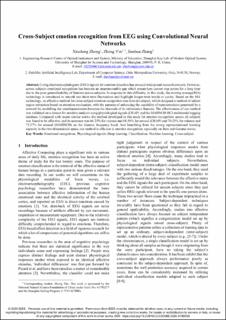| dc.contributor.author | Zhong, Xiaolong | |
| dc.contributor.author | Yin, Zhong | |
| dc.contributor.author | Zhang, Jianhua | |
| dc.date.accessioned | 2021-09-01T07:32:55Z | |
| dc.date.available | 2021-09-01T07:32:55Z | |
| dc.date.created | 2020-10-07T11:59:12Z | |
| dc.date.issued | 2020-09-09 | |
| dc.identifier.citation | Chinese Control Conference (CCC). 2020, 2020- 7516-7521. | en_US |
| dc.identifier.isbn | 978-9-8815-6390-3 | |
| dc.identifier.isbn | 978-1-7281-6523-3 | |
| dc.identifier.issn | 1934-1768 | |
| dc.identifier.uri | https://hdl.handle.net/11250/2772110 | |
| dc.description.abstract | Using electroencephalogram (EEG) signals for emotion detection has aroused widespread research concern. However, across subjects emotional recognition has become an insurmountable gap which researchers cannot step across for a long time due to the poor generalizability of features across subjects. In response to this difficulty, in this study, the moving average (MA) technology is introduced to smooth out short-term fluctuations and highlight longer-term trends or cycles. Based on the MA technology, an effective method for cross-subject emotion recognition was then developed, which designed a method of salient region extraction based on attention mechanism, with the purpose of enhancing the capability of representations generated by a network by modelling the interdependencies between the channels of its informative features. The effectiveness of our method was validated on a dataset for emotion analysis using physiological signals (DEAP) and the MAHNOB-HCI multimodal tagging database. Compared with recent similar works, the method developed in this study for emotion recognition across all subjects was found to be effective, and its accuracy was 66.23% for valence and 68.50% for arousal (DEAP) and 70.25% for valence and 73.27% for arousal (MAHNOB) on the Gamma frequency band. And benefiting from the strong representational learning capacity in the two-dimensional space, our method is efficient in emotion recognition especially on Beta and Gamma waves. | en_US |
| dc.language.iso | eng | en_US |
| dc.publisher | Institute of Electrical and Electronics Engineers | en_US |
| dc.relation.ispartof | 2020 39th Chinese Control Conference (CCC) | |
| dc.relation.ispartofseries | Chinese Control Conference (CCC);2020 39th Chinese Control Conference (CCC) | |
| dc.subject | Emotional recognition | en_US |
| dc.subject | Physiological signals | en_US |
| dc.subject | Deep learning | en_US |
| dc.subject | Classification | en_US |
| dc.subject | Machine learning | en_US |
| dc.subject | Cross-subjects | en_US |
| dc.title | Cross-Subject emotion recognition from EEG using Convolutional Neural Networks | en_US |
| dc.type | Peer reviewed | en_US |
| dc.type | Journal article | en_US |
| dc.description.version | acceptedVersion | en_US |
| dc.rights.holder | © 2020 IEEE | en_US |
| cristin.ispublished | true | |
| cristin.fulltext | original | |
| cristin.fulltext | postprint | |
| cristin.qualitycode | 1 | |
| dc.identifier.doi | https://doi.org/10.23919/CCC50068.2020.9189559 | |
| dc.identifier.cristin | 1837877 | |
| dc.source.journal | Chinese Control Conference (CCC) | en_US |
| dc.source.volume | 2020- | en_US |
| dc.source.issue | 2020 39th Chinese Control Conference (CCC) | en_US |
| dc.source.pagenumber | 7516-7521 | en_US |
